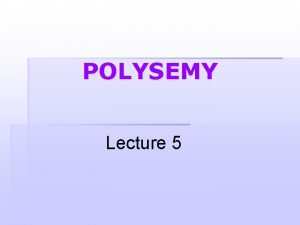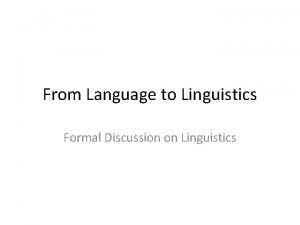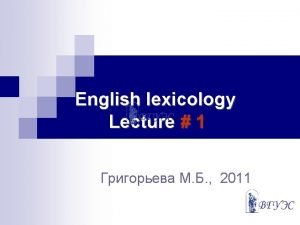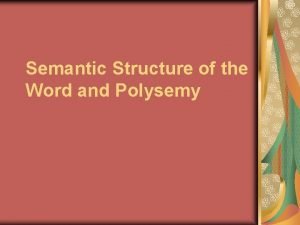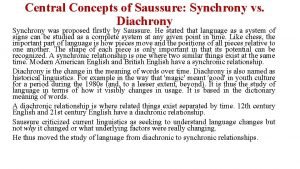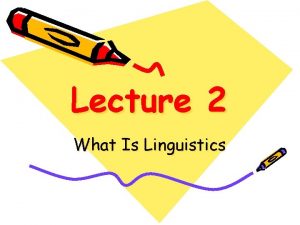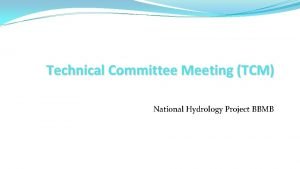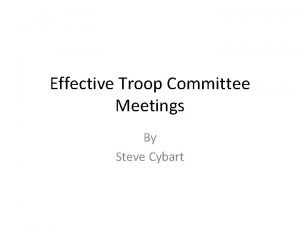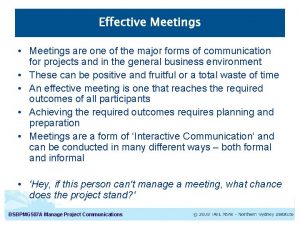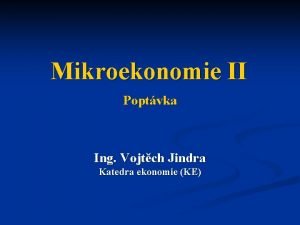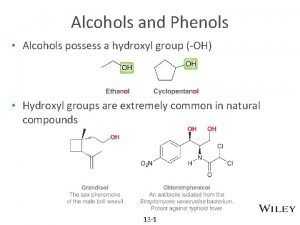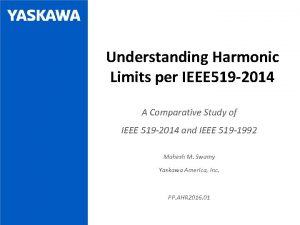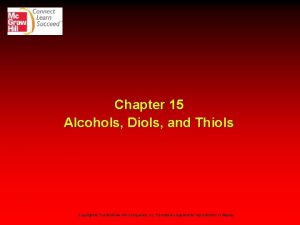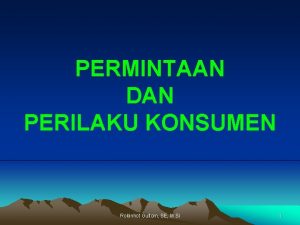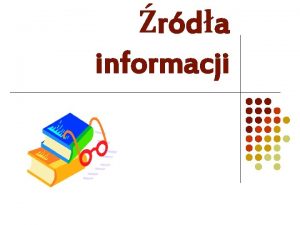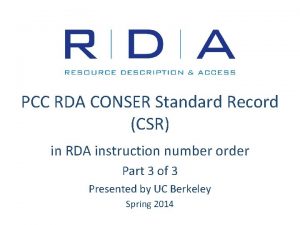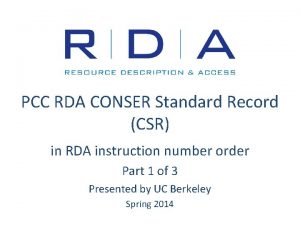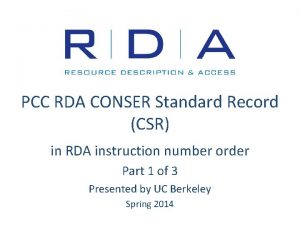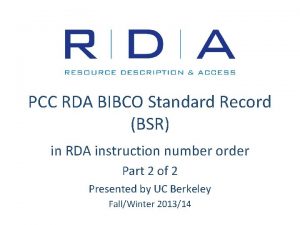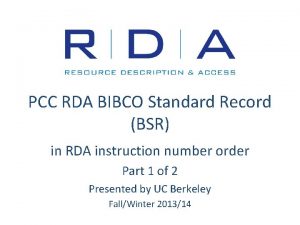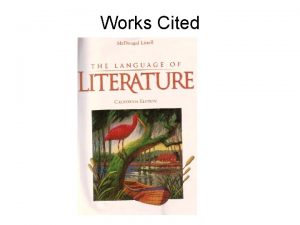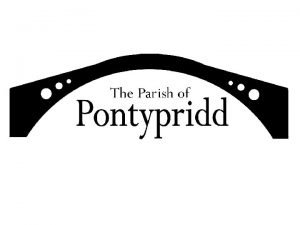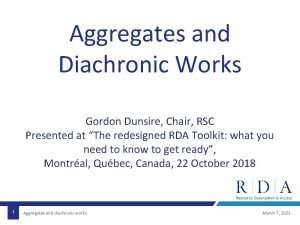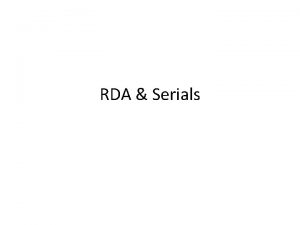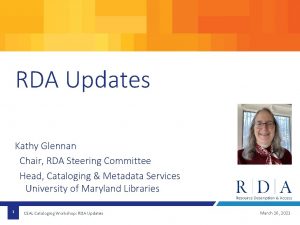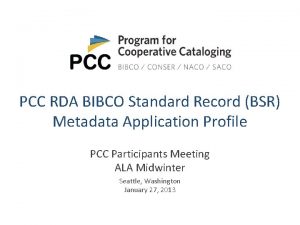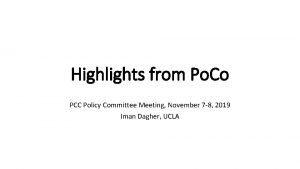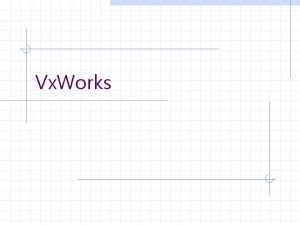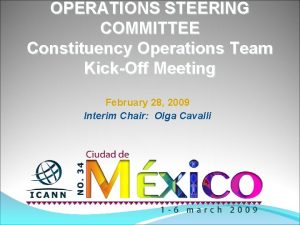Diachronic works in RDA PCC Operations Committee meeting













![Work is a transformation of Work [LRM-R 22] Transformation by audience Carrier version Language Work is a transformation of Work [LRM-R 22] Transformation by audience Carrier version Language](https://slidetodoc.com/presentation_image/5d6e9194921abe67d0a1feadd28b524a/image-14.jpg)










- Slides: 24

Diachronic works in RDA PCC Operations Committee meeting Library of Congress, 2 May 2019

What is a diachronic work? A diachronic work is a work that is planned to be embodied over time, rather than as a single “act of publication”. The essence of a diachronic work is a plan for the change of content. Change of content = extension of content

How is content extended? By accumulation (the addition of content in discrete physical or logical units): successive works By replacement (new content is integrated with—and may replace—existing content): integrating works In RDA these methods are specified by the extension plan element of the work entity

What is the extension plan element? The extension plan element is a categorization combining values from two extension attributes of the RDA/ONIX Framework for Resource Categorization: Extension mode (succession or integration) Extension termination (whether or not period of extension has a predetermined end: determinate or indeterminate) There is an additional category for resources with a static (nondiachronic) plan

How are the values of the extension plan element recorded? There is an RDA vocabulary encoding scheme (VES) for extension plan, with five possible values: Integrating determinate plan Integrating indeterminate plan Static plan Successive determinate plan Successive indeterminate plan

Integrating determinate plan ROF extension mode INTEGRATION ROF extension termination DETERMINATE RDA extension plan INTEGRATING DETERMINATE

Integrating indeterminate plan ROF extension mode INTEGRATION ROF extension termination INDETERMINATE RDA extension plan INTEGRATING INDETERMINATE

Static plan ROF extension mode N/A ROF extension termination N/A RDA extension plan STATIC

Successive determinate plan ROF extension mode SUCCESSION ROF extension termination DETERMINATE RDA extension plan SUCCESSIVE DETERMINATE

Successive indeterminate plan ROF extension mode SUCCESSION ROF extension termination INDETERMINATE RDA extension plan SUCCESSIVE INDETERMINATE Serial work

How does this relate to IFLA LRM? IFLA LRM (5. 8 Modelling of serials) regards any serial as “a distinct instance of the work entity” [i. e. serials have a WEM lock] and uses specific relationships among these instances to connect them The modeling of diachronic works in RDA is extrapolated from this modeling of serials in IFLA LRM

So does a work with a diachronic extension plan have a WEM lock? Yes, any work with a diachronic extension plan may be realized in one and only one expression and embodied in one and only one manifestation, a 1: 1 cardinality in each case Any work with a static extension plan adheres to the standard WEMI cardinality: it may be realized in one or more expressions and embodied in one or more manifestations, a 1: M cardinality in each case

Come again? RDA explains this in terms of transformation boundaries A transformation boundary is a stage at which a work is treated as a new work separate from the existing work For static works, a difference in content between two expressions is a necessary but insufficient indicator that each expression realizes a different work (no transformation boundary has necessarily been crossed) For diachronic works, the potential for a difference in content (inherent in the fact that content is embodied over time) between two manifestations is sufficient in itself to indicate that each manifestation embodies a different expression and those expressions realize different works (the transformation boundary has been crossed)
![Work is a transformation of Work LRMR 22 Transformation by audience Carrier version Language Work is a transformation of Work [LRM-R 22] Transformation by audience Carrier version Language](https://slidetodoc.com/presentation_image/5d6e9194921abe67d0a1feadd28b524a/image-14.jpg)
Work is a transformation of Work [LRM-R 22] Transformation by audience Carrier version Language version Regional version Transformation by genre Transformation by policy Transformation by extension plan Transformation by style

So how does this affect continuing resources? Not much For CR, RDA is simply implementing the IFLA LRM modeling of serials Aligns more closely with ISSN practice Pretty much reflects current CONSER practice Preferred title of translations and languages editions = title proper

What about multipart monographs issued over time? RDA treats any multipart monograph issued over time as a diachronic work with a successive determinate extension plan RDA no longer treats “multipart monograph” as a mode of issuance Extension plan: successive determinate plan Mode of issuance: multiple unit

Can you give an example? Encyclopædia Britannica (3 rd edition) Initially published from 1788 to 1797 in ca. 300 fascicles Volume title pages issued later, all with “ 1797” as date of publication

Now it’s getting personal… w 1 (static work): My dissertation e 1 Typescript (with diskettes in pocket) e 2 Typescript (without diskettes or pocket) m 1 Microfilm m 2+ Publish-on-demand from microfilm (several size and binding options) m 3 Digitized microfilm (Pro. Quest online products) w 2 (diachronic work): My dissertation, slightly abridged and published under what I thought was a catchier title in the vain hope of attracting a wider audience (or indeed any audience at all) W 2. 1 -2. 2 Contributions to 2 successive issues of Cataloging & Classification Quarterly

How do I now bring together works that RDA might formerly have considered expressions of a single work? RDA permits closely related works to be treated as work groups Descriptions of these works might be brought together by recording an appellation of work group (assigned from a vocabulary encoding scheme) as part of the description of each work

For example, The Economist Authorized access point for work group: Economist (London, England : 1843) Drawn from LCNAF vocabulary encoding scheme (VES) LCCN: no 2019022928 http: //id. loc. gov/authorities/names/no 2019022928 Identifier for work group: 0013 -0613 Drawn from ISSN-L vocabulary encoding scheme (VES) IRI: https: //www. wikidata. org/wiki/Q 180089

For example, Encyclopædia Britannica Authorized access point for work group: Encyclopaedia Britannica Drawn from LCNAF vocabulary encoding scheme (VES) LCCN: nr 89013909 http: //id. loc. gov/authorities/names/nr 89013909 IRI: https: //www. wikidata. org/wiki/Q 455

The future: relationships? Historically, we used uniform titles to bring together expressions and manifestations of works in the context of an alphabetical catalog. This has created a sizeable store of legacy data predicated on this mechanism for collocation Prospectively, appellations of work groups may serve this purpose (though the underlying semantics may be a bit messy) In a linked data environment, however, relationship matrices may increasingly serve this purpose: Work A transformation by extension plan of Work B

The present: pragmatic question (MARC / BIBFRAME) How will one identify an RDA authorized access point for work group (identifying the members of a work group) in MARC or BIBFRAME? Part of the larger question of mapping from RDA to MARC and/or BIBFRAME and vice versa Currently we map in our heads, which is not really a satisfactory Linked Data solution

Fin ejones@nu. edu
 Historical changeability of semantic structure
Historical changeability of semantic structure What is linguistics
What is linguistics Special lexicology
Special lexicology Synchronic and diachronic linguistics
Synchronic and diachronic linguistics μεταφραση7
μεταφραση7 Semantic structure of a word
Semantic structure of a word Synchrony and diachrony
Synchrony and diachrony Synchronic vs diachronic
Synchronic vs diachronic Traffic management
Traffic management Tcm technical committee meeting
Tcm technical committee meeting Bsa troop committee meeting agenda
Bsa troop committee meeting agenda Steering committee meeting agenda sample
Steering committee meeting agenda sample Safety committee meeting ppt
Safety committee meeting ppt For todays meeting
For todays meeting What is meeting and types of meeting
What is meeting and types of meeting Today meeting or today's meeting
Today meeting or today's meeting What is meeting and types of meeting
What is meeting and types of meeting Pcc křivka
Pcc křivka Pcc tuition appeal
Pcc tuition appeal What does pcc ch2cl2 do
What does pcc ch2cl2 do Ieee 519 1992
Ieee 519 1992 Pcc moodle
Pcc moodle Primary alcohol examples
Primary alcohol examples Contoh soal kurva pcc
Contoh soal kurva pcc Pcc benefits
Pcc benefits
